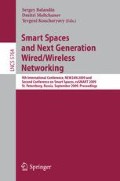Abstract
Context awareness and prediction are important for pervasive computing systems. The recently developed theory of context spaces addresses problems related to sensor data uncertainty and high-level situation reasoning. This paper proposes and discusses componentized context prediction algorithms and thus extends the context spaces theory. This paper focuses on two questions: how to plug-in appropriate context prediction techniques, including Markov chains, Bayesian reasoning and sequence predictors, to the context spaces theory and how to estimate the efficiency of those techniques. The paper also proposes and presents a testbed for testing a variety of context prediction methods. The results and ongoing implementation are also discussed.
Access this chapter
Tax calculation will be finalised at checkout
Purchases are for personal use only
Preview
Unable to display preview. Download preview PDF.
References
Ashbrook, D.: Learning significant locations and predicting user movement with gps. In: ISWC 2002: Proceedings of the 6th IEEE International Symposium on Wearable Computers, Washington, DC, USA. IEEE Computer Society, Los Alamitos (2002)
Albrecht, D.W., Zukerman, I., Nicholson, A.E.: Pre-sending documents on the WWW: A comparative study. In: IJCAI 1999 – Proceedings of the Sixteenth International Joint Conference on Artificial Intelligence (1999)
Bestavros, A.: Speculative data dissemination and service to reduce server load, network traffic and service time in distributed information systems. In: Proceedings of the 1996 International Conference on Data Engineering (1996)
Bhattacharya, A., Das, S.K.: Lezi update: An information-theoretic approach to track mobile users in PCS networks. In: Mobile Computing and Networking, pp. 1–12 (1999)
Cappe, O., Moulines, E., Ryden, T.: Inference in Hidden Markov Models. Springer, Heidelberg (2005)
Dey, A.K., Abowd, G.D.: Towards a better understanding of context and context-awareness. Technical report (1999)
Das, S.K., Cook, D.J., Bhattacharya, A., Heierman III, E.O., Lin, T.-Y.: The role of prediction algorithms in the MavHome smart home architecture. IEEE Wireless Communications 9(6), 77–84 (2003)
Davison, B.D., Hirsh, H.: Toward an adaptive command line interface. In: Advances in Human Factors/Ergonomics: Design of Computing Systems: Social and Ergonomic Considerations, pp. 505–508. Elsevier Science Publishers, San Francisco (1997); Proceedings of the Seventh International Conference on Human-Computer Interaction
Davison, B.D., Hisrch, H.: Probabilistic online action prediction. In: Proceedings of the AAAI Spring Symposium on Intelligent Environments (1998)
Gopalratnam, K., Cook, D.J.: Active Lezi: An incremental parsing algorithm for sequential prediction. In: Proceedings of the Florida Artificial Intelligence Research Symposium (2003)
Gellert, A., Vintan, L.: Person Movement Prediction Using Hidden Markov Models. Studies in Informatics and Control 15(1) (March 2006)
Haykin, S.: Neural Networks: A Comprehensive Foundation, 2nd edn. Prentice Hall, Englewood Cliffs (1999)
Kaowthumrong, K., Lebsack, J., Han, R.: Automated selection of the active device in interactive multi-device smart spaces (2002)
Mozer, M.C.: The neural network house: An environment that adapts to its inhabitants. In: Proceedings of the AAAI 1998 Spring Symposium on Intelligent Environments, pp. 110–114. AAAI Press, Menlo Park (1998)
Mayrhofer, R., Radi, H., Ferscha, A.: Recognizing and predicting context by learning from user behavior. Radiomatics: Journal of Communication Engineering, special issue on Advances in Mobile Multimedia 1(1) (May 2004)
Nurmi, P., Martin, M., Flanagan, J.A.: Enabling proactiviness through Context Prediction. In: Proc. Workshop on Context Awareness for Proactive Systems, pp. 159–168. Helsinki University Press, Helsinki (2005)
Padovitz’s, A.: Context Management and Reasoning about Situations in Pervasive Computing, PhD Theses, Caulfield School of Information Technology, Monash University, Australia (2006)
Petzold, J., Bagci, F., Trumler, W., Ungerer, T.: Context Prediction Based on Branch Prediction Methods (July 2003)
Padovitz, A., Loke, S.W., Zaslavsky, A.: Towards a theory of context spaces. In: Proceedings of the Second IEEE Annual Conference on Pervasive Computing and Communications Workshops, 2004, pp. 38–42 (2004)
Padovitz, A., Loke, S.W., Zaslavsky, A.: The ECORA framework: A hybrid architecture for context-oriented pervasive computing. Pervasive and Mobile Computing 4(2), 182–215 (2008)
Petzold, J., Pietzowski, A., Bagci, F., Trumler, W., Ungerer, T.: Prediction of Indoor Movements Using Bayesian Networks. In: Strang, T., Linnhoff-Popien, C. (eds.) LoCA 2005. LNCS, vol. 3479, pp. 211–222. Springer, Heidelberg (2005)
Roy, A., Das Bhaumik, S.K., Bhattacharya, A., Basu, K., Cook, D.J., Das, S.K.: Location aware resource management in smart homes, pp. 481–488 (2003)
Russell, S.J., Norvig, P.: Artificial Intelligence: A Modern Approach, 2nd edn. Prentice Hall, Englewood Cliffs (2003)
Shafer, G.: A Mathematical Theory of Evidence. Princeton University Press, Princeton (1976)
Vintan, L., Gellert, A., Petzold, J., Ungerer, T.: Person Movement Prediction Using Neural Networks. In: First Workshop on Modeling and Retrieval of Context, Ulm, Germany (September 2004)
Ziv, J., Lempel, A.: Compression of individual sequences via variable-rate coding. IEEE Transactions on Information Theory 24(5), 530–536 (1978)
How to Build a Combined Agent Based / System Dynamics Model Logic in AnyLogic (2008), http://www.xjtek.com/file/161
Author information
Authors and Affiliations
Editor information
Editors and Affiliations
Rights and permissions
Copyright information
© 2009 Springer-Verlag Berlin Heidelberg
About this paper
Cite this paper
Boytsov, A., Zaslavsky, A., Synnes, K. (2009). Extending Context Spaces Theory by Predicting Run-Time Context. In: Balandin, S., Moltchanov, D., Koucheryavy, Y. (eds) Smart Spaces and Next Generation Wired/Wireless Networking. ruSMART NEW2AN 2009 2009. Lecture Notes in Computer Science, vol 5764. Springer, Berlin, Heidelberg. https://doi.org/10.1007/978-3-642-04190-7_2
Download citation
DOI: https://doi.org/10.1007/978-3-642-04190-7_2
Publisher Name: Springer, Berlin, Heidelberg
Print ISBN: 978-3-642-04188-4
Online ISBN: 978-3-642-04190-7
eBook Packages: Computer ScienceComputer Science (R0)

